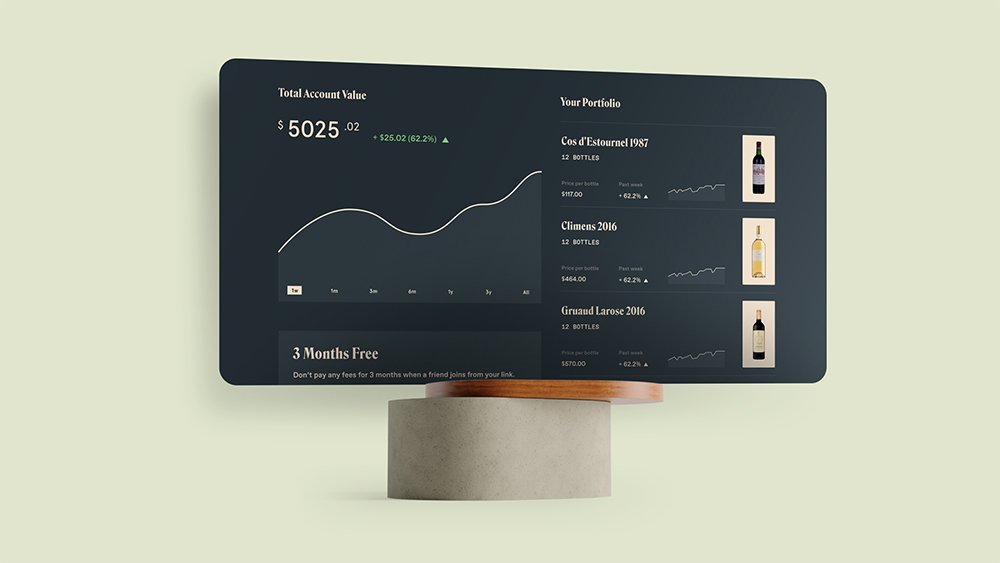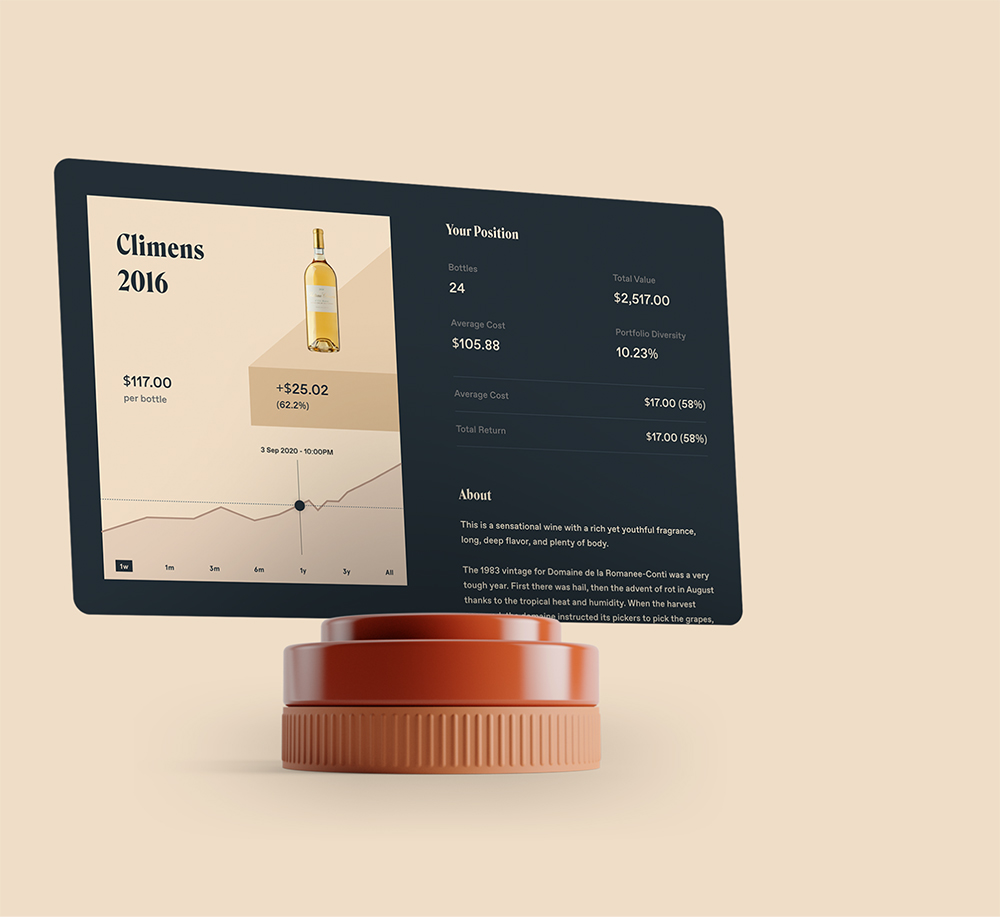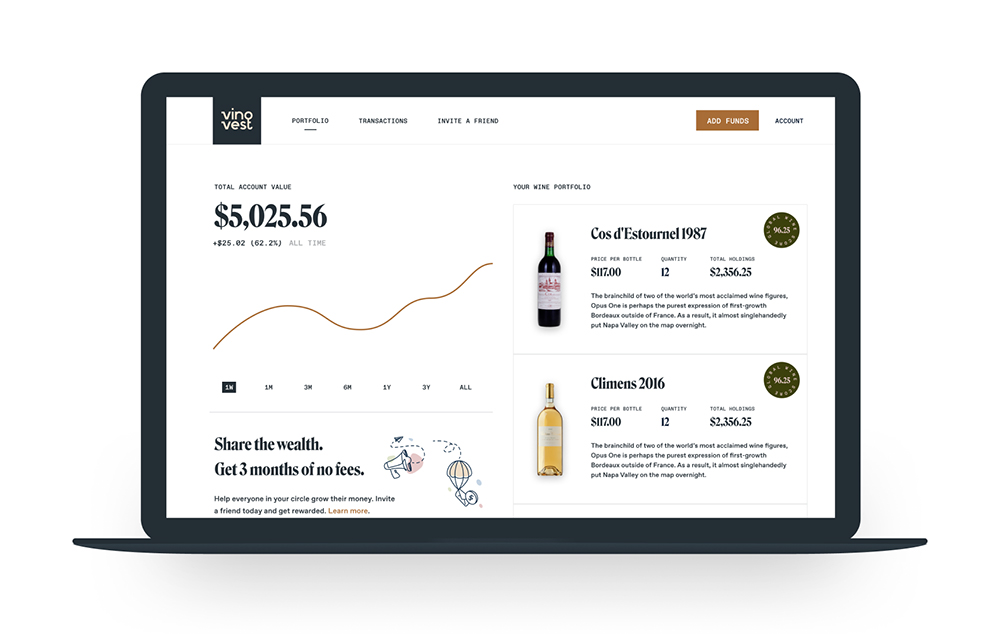
在大多數(shù)人看來,,投資葡萄酒似乎只是少數(shù)富豪的專屬,,是一種比較封閉的小眾愛好。很多名酒拍賣會都是在蘇富比(Sotheby’s),、Acker Merrall& Condit(AMC)和施氏佳釀(Zachys)等知名拍賣行舉行的,,競拍者都是全球前1%的富人。在這種拍賣會上,,一瓶于澤干邑動輒能夠拍出5.1萬美元的高價,,讓不少想進入品酒圈的新人咂舌不已。另外,,挑酒也是一門水很深的藝術,,有的紅酒存放的年頭越長,價格越高,,比如大名鼎鼎的拉菲酒莊(Chateau Lafite Rothschild)和羅曼尼康帝酒莊(Domaine de la Romanée-Conti)的酒,。如果你不提前好幾年預約,再交上幾萬美元的學費,,這種真正具有投資價值的名酒,,你基本上是一瓶也拿不到手的。
但是隨著最新科技平臺Vinovest的上線,,現(xiàn)在所有人都從事紅酒投資了,。
Vinovest的聯(lián)合創(chuàng)始人安東尼·張20多歲時就賣掉了自己在舊金山創(chuàng)辦的第一家公司,手里有了一些可以投資的積蓄,。安東尼·張本人是一名葡萄酒愛好者,,于是他開始尋找這個行業(yè)的投資機會,但始終不得其門而入——他發(fā)現(xiàn)自己既沒有雄厚的財力,,也不認識那些低調的名酒掮客,,跟那些多年的老藏家完全不在一條起跑線上。另外,,他也無法獲得名酒拍賣會的入場券,,更接觸不到那些藏家們趨之若鶩的酒莊。而只有這些酒莊的酒,,才具備巨大的投資價值,。
但他發(fā)現(xiàn),,自己能夠找到近幾十年來關于葡萄酒價格的大量公開數(shù)據(jù)。作為一位聰明的程序員,,他立即編寫了一個算法,,來預測哪些葡萄酒最有升值空間。五年之后,,這個算法變成了現(xiàn)在的Vinovest,,它可以代表用戶,通過機器學習技術,,從業(yè)內的頂級酒莊收購和銷售葡萄酒,。安東尼·張已經成立了一支11人的葡萄酒經紀、采購,、存儲,、保險和管理團隊。投資者也發(fā)現(xiàn)了紅酒投資的利潤,。2020年,,Vinovest的年化回報率中值超過了17%。
安東尼·張說:“酒是越陳越好,,同時也是越陳越少,,從而帶來了投資機會,因為它的價格會隨著時間而上漲,。不過從事和參與葡萄酒投資,,卻是一項很難讓人摸到頭緒而且價格不菲的活動。當時在我看來,,葡萄酒投資只適合那些已經很富有的人,,這讓我感到很不舒服?!?/p>

名酒的收藏與投資并非什么新鮮事物,但它的高門檻確實令很多潛在投資者望而卻步,,即便是紅酒行業(yè)的從業(yè)者也不敢輕易入坑,。一般情況下,投資者會通過佳士得(Christie’s)等老牌拍賣公司尋找值得投資的葡萄酒,,或者從私人藏家手中購買,。另外還能夠購買葡萄酒“期貨”,,也就是預售權,,比如波爾多、勃艮第和納帕谷等地的知名酒莊都會提前開展預售,。投資者也可以通過紅酒經紀商來打理與熱門酒莊的關系,,或者通過他們在拍賣會上鎖定合適的拍品,。拍下的紅酒會被送到由客戶個人管理的倉庫儲存起來,直到他們將這批紅酒再次出手,。名酒的銷售也是一件很嚴肅的事情,,所有待銷紅酒都需要經過專家的真品鑒定,以確認其原產地,,然后才有資格上拍賣會,。
這一套流程下來,既需要大量時間,,也需要不菲的資金,,通常至少要幾萬美元打底。要想通過投資名酒賺錢,,投資者不僅要有金融領域的知識,,還要能夠分析和預測10年、20年,、30年甚至更長時間的價格走勢,。安東尼·張起初將紅酒投資當作一項個人愛好,所以他并沒有留意自己在數(shù)據(jù)收集和構建初始模型上花費了多少時間,,但他絕對為此付出了大量的心血,。
Vinovest公司的顧問、品酒師喬納森·羅斯指出:“對于不經常接觸葡萄酒,,或者沒有親自購買和品嘗過足夠葡萄酒的人來說,,紅酒拍賣的‘水’是很深的?!绷_斯解釋道,,普通人在拍賣公司開戶的時候,是沒有人指導他們的,,他只能夠依賴以往的品酒和購酒經驗,,但這和酒的升值空間未必掛鉤?!澳惚仨氈滥男┚谱钸m合長期陳放,,哪個產地的哪塊葡萄園才可以釀出最有升值空間的酒。另外還有酒莊的生產質量和聲譽的問題,,這里還有很多主觀因素和灰色地帶,。”
而Vinovest的技術則抹掉了這些灰色地帶,。安東尼·張的算法分析了各種紅酒在不同時間跨度內的升值空間,、各種酒的飲用窗口(即最佳陳放時間)、各種因素與拍賣價格的相關性,、評論家的評分,、各種酒的技術分析指標,,以及所有可能影響紅酒價格的其他細節(jié)因素,以預判投資一瓶酒什么時候能夠盈利,。
“這樣一來,,在做投資決策時,大家就沒有必要再做很多金融分析了,?!卑矕|尼·張說。他也認為,,紅酒投資里存在很多主觀因素?!拔蚁胪ㄟ^做這樣一個軟件,采取一種更定量的分析方法,,來幫助那些對葡萄酒知少甚少的人,?!?/p>
那么,,Vinovest是怎樣幫到投資者的呢,?很簡單,,用戶可以先告訴Vinovest自己有多少錢能夠投資,,以及自己計劃的投資年限,。用戶本人甚至不必具備任何葡萄酒的專業(yè)知識,。然后Vinovest會向投資者推薦合適的葡萄酒產區(qū)和酒的類型,,然后幫助用戶完成從購酒,、存酒到保險和管理的全套手續(xù),,當然Vinovest也會收取少量手續(xù)費,。如果你的投資級別較高,,就有機會入手更珍稀的名酒,。Vinovest和別的股票管理平臺大同小異,,只不過它的產品有形的,而并非一串電子數(shù)據(jù),。

買來的酒去了哪兒呢,?多數(shù)時候,,它都會待在倉庫里,。安東尼·張已經建立了一個全球的儲存設施網絡。這樣一來就省去了運輸成本,,也免去了紅酒跨國運輸?shù)母哳~關稅和其他稅費,,這也就給投資者省了錢。
羅斯指出,,Vinovest是做紅酒投資的,,不是做紅酒收藏的,所以用戶不要指望把收購的紅酒擺在家里,,甚至是拿來自己喝,,那是收藏家才會干的事情,。葡萄酒投資的重點,,不在于你喜歡或者不喜歡什么,,而在于遠期的回報。畢竟一瓶酒一旦喝下了肚,,就再沒有什么投資回報可言了,。
安東尼·張稱,,各大酒莊都很樂于與他合作,,而他也更喜歡從酒莊和經銷商那里直接購酒,而不是通過拍賣行,,因為只有源頭采購才更放心,,同時紅酒在存儲,、運輸和保真等方面出問題的機率也更小,。各大酒莊青睞Vinovest還有另一個原因,那就是它帶來了很多新的投資者,,而且其中大都是年輕人——安東尼·張主要瞄準25歲到40歲的投資者,,因此他將最低投資額度限定在1000美元,,而且他在Instagram上也投放了廣告。他知道自己吸引不了那些平時只喝15美元一瓶的廉價紅酒的人,,但他有可能吸引到那些想在股市之外尋找高回報投資機會的人,,而這些人恰巧也對高檔西餐廳里的紅酒感興趣。
“為什么只有已經進入了這個小圈子的人,,才知道投資紅酒有這么高的回報呢,?”他說:“有了這個平臺,任何人都能夠投資紅酒,,不管他們住在哪里,,也不管他們來自什么背景。從這里開始,,大家可以很容易地了解到紅酒的投資類型,。”(財富中文網)
譯者:樸成奎
在大多數(shù)人看來,,投資葡萄酒似乎只是少數(shù)富豪的專屬,,是一種比較封閉的小眾愛好。很多名酒拍賣會都是在蘇富比(Sotheby’s),、Acker Merrall& Condit(AMC)和施氏佳釀(Zachys)等知名拍賣行舉行的,,競拍者都是全球前1%的富人。在這種拍賣會上,,一瓶于澤干邑動輒能夠拍出5.1萬美元的高價,,讓不少想進入品酒圈的新人咂舌不已。另外,,挑酒也是一門水很深的藝術,,有的紅酒存放的年頭越長,價格越高,,比如大名鼎鼎的拉菲酒莊(Chateau Lafite Rothschild)和羅曼尼康帝酒莊(Domaine de la Romanée-Conti)的酒,。如果你不提前好幾年預約,再交上幾萬美元的學費,,這種真正具有投資價值的名酒,,你基本上是一瓶也拿不到手的。
但是隨著最新科技平臺Vinovest的上線,,現(xiàn)在所有人都從事紅酒投資了,。
Vinovest的聯(lián)合創(chuàng)始人安東尼·張20多歲時就賣掉了自己在舊金山創(chuàng)辦的第一家公司,,手里有了一些可以投資的積蓄。安東尼·張本人是一名葡萄酒愛好者,,于是他開始尋找這個行業(yè)的投資機會,,但始終不得其門而入——他發(fā)現(xiàn)自己既沒有雄厚的財力,也不認識那些低調的名酒掮客,,跟那些多年的老藏家完全不在一條起跑線上,。另外,他也無法獲得名酒拍賣會的入場券,,更接觸不到那些藏家們趨之若鶩的酒莊,。而只有這些酒莊的酒,才具備巨大的投資價值,。
但他發(fā)現(xiàn),,自己能夠找到近幾十年來關于葡萄酒價格的大量公開數(shù)據(jù)。作為一位聰明的程序員,,他立即編寫了一個算法,,來預測哪些葡萄酒最有升值空間,。五年之后,,這個算法變成了現(xiàn)在的Vinovest,它可以代表用戶,,通過機器學習技術,,從業(yè)內的頂級酒莊收購和銷售葡萄酒。安東尼·張已經成立了一支11人的葡萄酒經紀,、采購,、存儲、保險和管理團隊,。投資者也發(fā)現(xiàn)了紅酒投資的利潤。2020年,,Vinovest的年化回報率中值超過了17%,。
安東尼·張說:“酒是越陳越好,,同時也是越陳越少,,從而帶來了投資機會,,因為它的價格會隨著時間而上漲。不過從事和參與葡萄酒投資,,卻是一項很難讓人摸到頭緒而且價格不菲的活動,。當時在我看來,,葡萄酒投資只適合那些已經很富有的人,,這讓我感到很不舒服,?!?/p>
名酒的收藏與投資并非什么新鮮事物,,但它的高門檻確實令很多潛在投資者望而卻步,,即便是紅酒行業(yè)的從業(yè)者也不敢輕易入坑。一般情況下,,投資者會通過佳士得(Christie’s)等老牌拍賣公司尋找值得投資的葡萄酒,,或者從私人藏家手中購買,。另外還能夠購買葡萄酒“期貨”,,也就是預售權,比如波爾多,、勃艮第和納帕谷等地的知名酒莊都會提前開展預售,。投資者也可以通過紅酒經紀商來打理與熱門酒莊的關系,,或者通過他們在拍賣會上鎖定合適的拍品,。拍下的紅酒會被送到由客戶個人管理的倉庫儲存起來,直到他們將這批紅酒再次出手,。名酒的銷售也是一件很嚴肅的事情,,所有待銷紅酒都需要經過專家的真品鑒定,,以確認其原產地,然后才有資格上拍賣會,。
這一套流程下來,,既需要大量時間,,也需要不菲的資金,,通常至少要幾萬美元打底,。要想通過投資名酒賺錢,投資者不僅要有金融領域的知識,,還要能夠分析和預測10年,、20年,、30年甚至更長時間的價格走勢,。安東尼·張起初將紅酒投資當作一項個人愛好,所以他并沒有留意自己在數(shù)據(jù)收集和構建初始模型上花費了多少時間,,但他絕對為此付出了大量的心血,。
Vinovest公司的顧問、品酒師喬納森·羅斯指出:“對于不經常接觸葡萄酒,,或者沒有親自購買和品嘗過足夠葡萄酒的人來說,,紅酒拍賣的‘水’是很深的,?!绷_斯解釋道,普通人在拍賣公司開戶的時候,,是沒有人指導他們的,,他只能夠依賴以往的品酒和購酒經驗,,但這和酒的升值空間未必掛鉤,。“你必須知道哪些酒最適合長期陳放,,哪個產地的哪塊葡萄園才可以釀出最有升值空間的酒,。另外還有酒莊的生產質量和聲譽的問題,這里還有很多主觀因素和灰色地帶,。”
而Vinovest的技術則抹掉了這些灰色地帶,。安東尼·張的算法分析了各種紅酒在不同時間跨度內的升值空間,、各種酒的飲用窗口(即最佳陳放時間),、各種因素與拍賣價格的相關性、評論家的評分,、各種酒的技術分析指標,,以及所有可能影響紅酒價格的其他細節(jié)因素,以預判投資一瓶酒什么時候能夠盈利,。
“這樣一來,,在做投資決策時,大家就沒有必要再做很多金融分析了,?!卑矕|尼·張說,。他也認為,紅酒投資里存在很多主觀因素,?!拔蚁胪ㄟ^做這樣一個軟件,采取一種更定量的分析方法,,來幫助那些對葡萄酒知少甚少的人,。”
那么,,Vinovest是怎樣幫到投資者的呢,?很簡單,用戶可以先告訴Vinovest自己有多少錢能夠投資,,以及自己計劃的投資年限,。用戶本人甚至不必具備任何葡萄酒的專業(yè)知識。然后Vinovest會向投資者推薦合適的葡萄酒產區(qū)和酒的類型,,然后幫助用戶完成從購酒,、存酒到保險和管理的全套手續(xù),當然Vinovest也會收取少量手續(xù)費,。如果你的投資級別較高,,就有機會入手更珍稀的名酒。Vinovest和別的股票管理平臺大同小異,,只不過它的產品有形的,,而并非一串電子數(shù)據(jù)。
買來的酒去了哪兒呢,?多數(shù)時候,,它都會待在倉庫里。安東尼·張已經建立了一個全球的儲存設施網絡,。這樣一來就省去了運輸成本,,也免去了紅酒跨國運輸?shù)母哳~關稅和其他稅費,這也就給投資者省了錢,。
羅斯指出,,Vinovest是做紅酒投資的,不是做紅酒收藏的,,所以用戶不要指望把收購的紅酒擺在家里,,甚至是拿來自己喝,那是收藏家才會干的事情,。葡萄酒投資的重點,,不在于你喜歡或者不喜歡什么,而在于遠期的回報,。畢竟一瓶酒一旦喝下了肚,,就再沒有什么投資回報可言了,。
安東尼·張稱,各大酒莊都很樂于與他合作,,而他也更喜歡從酒莊和經銷商那里直接購酒,,而不是通過拍賣行,因為只有源頭采購才更放心,,同時紅酒在存儲,、運輸和保真等方面出問題的機率也更小。各大酒莊青睞Vinovest還有另一個原因,,那就是它帶來了很多新的投資者,,而且其中大都是年輕人——安東尼·張主要瞄準25歲到40歲的投資者,因此他將最低投資額度限定在1000美元,,而且他在Instagram上也投放了廣告,。他知道自己吸引不了那些平時只喝15美元一瓶的廉價紅酒的人,但他有可能吸引到那些想在股市之外尋找高回報投資機會的人,,而這些人恰巧也對高檔西餐廳里的紅酒感興趣,。
“為什么只有已經進入了這個小圈子的人,才知道投資紅酒有這么高的回報呢,?”他說:“有了這個平臺,,任何人都能夠投資紅酒,不管他們住在哪里,,也不管他們來自什么背景,。從這里開始,大家可以很容易地了解到紅酒的投資類型,?!保ㄘ敻恢形木W)
譯者:樸成奎
Investing in blue-chip wines seems, to most, like an activity for a closed club of wealthy collectors. Many fine wine auctions are held at well-known houses like Sotheby’s, Acker Merrall& Condit, and Zachys that seem geared for the world’s one percent—places where Jay-Z auctions off a $52,000 bottle of D’Ussé cognac. It’s the type of atmosphere that feels intimidating to someone who is newer to the game. The same goes for snagging cases, or even a single bottle, of the most expensive wines in the world, like Chateau Lafite Rothschild and Domaine de la Romanée-Conti, which gain immense value over time. Without spending years on the waiting list for an allocation, and snapping up tens of thousands of dollars in other wine from gatekeepers, you don’t have much hope of acquiring any for yourself.
But that’s changing with technology platform Vinovest, which allows anyone and everyone to invest in fine and rare wine.
When Vinovest cofounder Anthony Zhang was in his early twenties, he found himself looking for a great place to invest some extra savings he had on hand after selling his first startup in San Francisco. Being a fan of wine, he started researching opportunities in the industry. He quickly felt shut out: He wasn’t a longtime collector with deep pockets and connections to secretive brokers; he couldn’t get invitations to exclusive wine auctions; and he didn’t have access to allocations from some of the most sought-after producers, whose wines fetch large returns on investment.
What he could find: a massive amount of public data on wine prices over the course of decades. Like any savvy programmer, he wrote an algorithm to predict which bottles would be the best to seek out. Five years later, that strategy has become Vinovest, which uses machine-learning technology to acquire and sell bottles from top producers on behalf of its users. Zhang’s team of 11 handles the brokers, buying, storage, insurance, and management. Investors see profits. The annualized median returns in 2020 were more than 17%.
“Wine gets better with age but also scarcer, which makes it an investment because the price will increase with time,” Zhang says. “Getting access and being able to participate, though, was confusing and expensive. It seemed to me that wine investing was only something for people who were already wealthy. That didn’t sit well with me.”
The wine asset class is nothing new, but, as Zhang says, access to the space has proved daunting for potential investors, even those who already work in the wine industry. Traditionally, wine investors look for bottles at auctions hosted by heritage companies like Christie’s; estate sales of private collectors; or through futures, which are essentially presales, of major wines like those from Bordeaux, Burgundy, and Napa Valley. Brokers work with investors to help them manage relationships with in-demand producers and find the right lots to bid on at auctions they may attend. Any acquired wines are then shipped to storage managed by the individual until he or she wants to resell the products in future. To sell is an undertaking in and of itself, one that involves steps like approvals from authenticity specialists to confirm provenance before an auction house will accept cases of wine to be sold.
To run the entire process takes a significant amount of time and access to capital, typically tens of thousands of dollars. To be successful, it takes financial knowledge and prediction analysis of what may sell in 10, 20, 30 years—or more. Zhang considered his wine investing project to be a hobby at first, so he didn’t track how many hours he spent gathering data for his original financial model. But it was a lot.
“Auctions and the like are tough to navigate for anyone that does not work with that caliber of wine on a regular basis, or has bought and drank enough wine to figure it out for themselves,” says Jonathan Ross, a master sommelier and adviser to Vinovest. Ross explains that when an individual signs up for an account at traditional auction houses, there is no one to guide them. One must rely on acquired wine experience, and that’s not necessarily related to financial performance. “It has always been based on knowing what vintage is best suited for long-term aging, and from which parcel of vines within a small, esoteric, delimited vineyard,” he adds. “And that doesn’t even scratch the surface of producer quality and reputation. There’s a lot of subjectivity and gray areas there.”
Vinovest’s technology takes away the gray areas. Zhang built an algorithm based on which wines would gain value over a variety of different timelines, using data around drinking windows (the optimal time to age a wine), how that historically relates to sales at auctions, critics’ scores, technical analysis indicators, and any other details that could affect price. All of this predicts when a specific wine can turn a profit.
“People aren’t necessarily doing a lot of financial analysis into those decisions,” Zhang says, echoing Ross’s sentiment about the subjectivity of investing in wine. “I wanted to take a more quantitative approach to see if I could make a case for using software, as someone who knew little about the wine world.”
How that helps an investor is simple. Users give Vinovest information on how much they want to invest and when they expect to see a return. They don’t even have to know anything about wine. The program recommends what region and type of wine that investor’s portfolio will focus on, then handles the acquisition, storage, insurance, and management for a small fee. Different levels of investment allow access to rarer or more exclusive wines. It’s like any other stock management platform, except that the product is tangible rather than electronic.
Where does that wine go? In most cases, it doesn’t leave its warehouse. Zhang built out a network of storage facilities around the globe. That eliminates shipping costs as well as hefty taxes and tariffs on transporting alcohol across country lines. That savings is passed along to the investor.
Ross is quick to point out that Vinovest is about wine investing, not collecting, so users shouldn’t expect to ever physically hold a bottle. A collector may want the wine within arm’s reach, so that he or she can pop it open for dinner. With wine investing, it’s less about what you like and don’t like, and more about what will see a return in the future. After all, it would be detrimental to one’s return on investment to drink the wine he or she has purchased, he adds.
Zhang says that producers are excited to work with him. He decided to work directly with wineries and distributors versus auction houses, since he felt more confident buying bottles for investment from the source. There would be less chance of variation in a wine’s storage, transport, and authenticity. What he’s found is that they appreciate his goal of providing access to a new set of investors, primarily younger ones: Zhang targets the 25- to 40-year-old market by placing the minimum investment at $1,000 and even running ads on Instagram. He knows he won’t be converting the person who drinks $15 bottles from the grocery store, but he might grab someone who is seeking a new lucrative asset class outside of stocks, and who also happens to enjoy perusing the wine list at an upscale restaurant.
“Why should the only people with a chance to see such high returns be the ones who are already in the room?” he says. “With this platform, anyone could do it, regardless of where they live or what their background is. It’s an easy starting point where one can learn about the investment type of wine.”






